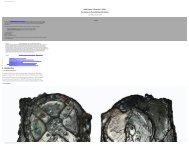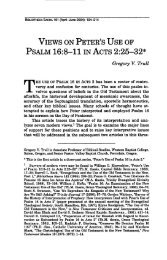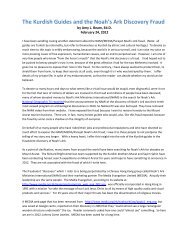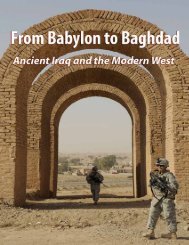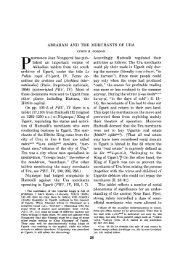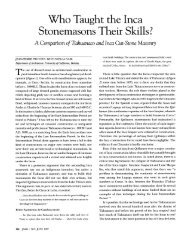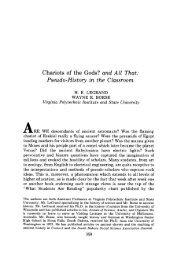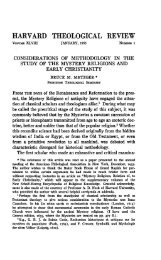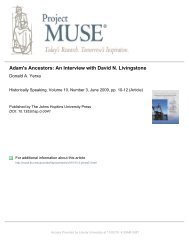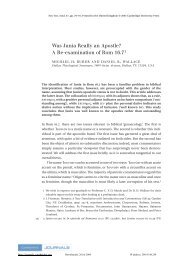The Myth of a 12th Planet: - Michael S. Heiser
The Myth of a 12th Planet: - Michael S. Heiser
The Myth of a 12th Planet: - Michael S. Heiser
Create successful ePaper yourself
Turn your PDF publications into a flip-book with our unique Google optimized e-Paper software.
Introduction<br />
<strong>The</strong> <strong>Myth</strong> <strong>of</strong> a 12 th <strong>Planet</strong>:<br />
A Brief Analysis <strong>of</strong> Cylinder Seal VA 243<br />
<strong>Michael</strong> S. <strong>Heiser</strong><br />
Ph.D. candidate, Hebrew Bible and Ancient Semitic Languages<br />
University <strong>of</strong> Wisconsin-Madison<br />
Readers <strong>of</strong> Zecharia Sitchin’s books, particularly <strong>The</strong> 12 th <strong>Planet</strong>, will recognize the above seal, VA<br />
243 (so named because it is number 243 in the collection <strong>of</strong> the Vorderasiatische Museum in<br />
Berlin). This seal is the centerpiece <strong>of</strong> Sitchin’s theory that the Sumerians had advanced<br />
astronomical knowledge <strong>of</strong> the planetary bodies in our solar system. This knowledge was<br />
allegedly given to the Sumerians by extraterrestrials, whom Sitchin identifies as the Anunnaki<br />
gods <strong>of</strong> Sumero-Mesopotamian mythology. In the upper left-hand corner <strong>of</strong> the seal, Sitchin<br />
argues, one sees the sun surrounded by eleven globes. Since ancient peoples (including the<br />
Sumerians according to Sitchin) held the sun and moon to be “planets,” these eleven globes plus<br />
the sun add up to twelve planets. Of course, since we now know <strong>of</strong> nine planets plus our sun and<br />
moon, part <strong>of</strong> Sitchin’s argument is that the Sumerians knew <strong>of</strong> an extra planet beyond Pluto.<br />
This extra planet is considered by Sitchin to be Nibiru, an astronomical body mentioned in<br />
Mesopotamian texts. Sitchin’s works detail his contention that Nibiru passes through our solar<br />
system every 3600 years, and so some believers in Sitchin’s theory contend that Nibiru will return<br />
soon. Some followers <strong>of</strong> Sitchin’s ideas also refer to Nibiru as “<strong>Planet</strong> X”.<br />
Is Sitchin correct – in whole or in part? Is Nibiru a 12 th planet that will soon return? Does VA243<br />
prove his thesis? Unfortunately for Sitchin and his followers, the answer to each <strong>of</strong> these<br />
questions is no. This paper will focus on the heart <strong>of</strong> his theory, VA243. Nibiru is the subject <strong>of</strong><br />
another paper on my website.
Method and Approach<br />
<strong>The</strong> study <strong>of</strong> cylinder seals is actually a very specialized sub-discipline within Sumerology and<br />
Assyriology. a It is possible to determine, through the efforts <strong>of</strong> cylinder seal specialists <strong>of</strong> the<br />
recent past and current experts, to decisively say that Sitchin’s interpretation <strong>of</strong> this seal is<br />
deeply flawed and lacks scholarly merit. In short, his theory is false and is unsupported by the<br />
seal itself.<br />
In the discussion that follows, I will demonstrate that VA243 in no way supports Sitchin’s ideas.<br />
My reasons / lines <strong>of</strong> argument for this are:<br />
1) <strong>The</strong> inscription on the seal (left hand and right hand sides – which are not discussed by<br />
Sitchin) says nothing about planets or any element <strong>of</strong> astronomy. Rather than <strong>of</strong>fering an<br />
independent translation, I will defer to authorities on Sumerian seal inscriptions in this<br />
regard to avoid any charge <strong>of</strong> bias.<br />
2) <strong>The</strong> alleged “sun” symbol on the seal is not the sun. We know this because it does not<br />
conform to the consistent depiction <strong>of</strong> the sun in hundreds <strong>of</strong> other cylinder seals and<br />
examples <strong>of</strong> Sumero-Mesopotamian artwork. I will describe the typical depiction<br />
(determined with certainty because it appears with texts about the sun god [Shamash<br />
Akkadian, known as Utu in Sumerian]) and provide image examples. Sources are<br />
provided for readers to check for themselves. <strong>The</strong> “sun” symbol is actually a star (which in<br />
Mesopotamian art could have six or, more commonly, eight points). Lest the modern<br />
reader retort that “well, the sun is a star,” I <strong>of</strong>fer several images where the star symbol<br />
and the sun symbol (which again, is not that in VA243) are side-by-side and distinct from<br />
one another. <strong>The</strong> Sumerians and Mesopotamians distinguished the sun from stars by using<br />
different symbols – and associating each symbol with the sun god and other gods,<br />
respectively. <strong>The</strong>re is simply no ancient Sumero-Akkadian evidence to support Sitchin’s<br />
identification.<br />
3) If the “sun” is not the sun, then what are the dots? <strong>The</strong> dots are also stars, as is best<br />
illustrated by the Sumerian-Mesopotamian depiction <strong>of</strong> the Pleaides (seven dots together<br />
with reasonable astronomical accuracy since they are visible to the naked eye). b <strong>The</strong><br />
Pleaides are actually one <strong>of</strong> the most frequently depicted astronomical features in Sumero-<br />
Mesopotamian art. As Sitchin points out (and this is corroborated by actual scholars in the<br />
field - it’s common knowledge), stars were associated with or considered to be heavenly<br />
beings – gods. In Sumero-Mesopotamian artwork, a star represents either a god or an<br />
astronomical body. <strong>The</strong> same can be said <strong>of</strong> the sun – it can either reference the literal<br />
sun or the sun god. <strong>The</strong>re are three possibilities as to what VA243 is depicting:<br />
(A) It is singling out a deity or special star and associating it with other stars in some<br />
sort <strong>of</strong> zodiacal representation. I don’t consider this likely because there are other<br />
far clearer representations <strong>of</strong> zodiacal constellations. Unless there are clear<br />
zodiacal connotations, a star was symbolic <strong>of</strong> a deity, which brings us to the second<br />
option.<br />
(B) More probable is the idea that the central star stands for a deity that has some<br />
association with fertility (as in crops) since the inscription describes an <strong>of</strong>fering<br />
made by a worshipper (who is named) to a seated god who is associated in the<br />
seal with fertile harvest. Since there are two other figures in the seal in addition to<br />
the seated god, and one is the <strong>of</strong>ferer, the remaining figure is likely a deity also<br />
associated with the <strong>of</strong>fering. In favor <strong>of</strong> this possibility are the “implements”<br />
a An excellent general introduction is Dominique Collon, Cylinder Seals.<br />
b I am not saying the star is depicted amid the Pleiades, only that the artistic depiction <strong>of</strong> the Pleiades provides an excellent<br />
example <strong>of</strong> “dots” = stars. <strong>The</strong> Pleiadean depiction is always seven dots/stars.
shown on the seal with respect to these two figures facing the seated god and the<br />
figure’s headdress. Also in its favor is the fact that there are literally hundreds <strong>of</strong><br />
such “<strong>of</strong>fering seals,” and many have a star in upper proximity to the figures’<br />
heads, signifying the figure is a deity (see the example).<br />
(C) Since the star is surrounded by eleven other stars (dots), the artistic depiction<br />
could stand for the lead god <strong>of</strong> the Mesopotamian divine council and its other<br />
eleven (upper tier) members. Recall that (as Sitchin again points out) the<br />
Mesopotamian council had 12 members. I have noted before that the 12 member<br />
council isn’t always consistent in Mesopotamian religion (at times eight gods are<br />
considered the council), but 12 is the more prevalent number. This thesis is<br />
attractive, but I can’t say there is much to commend it over option B. <strong>The</strong> reader<br />
might be thinking at this point, “Well, isn’t the sun god the leader <strong>of</strong> the pantheon<br />
– so if this symbology points to the divine council the center symbol could still be<br />
the sun?” This would be an erroneous line <strong>of</strong> thought since in Sumero-<br />
Mesopotamian religion the sun god is NOT the high god; the high god is Anu (later,<br />
Marduk), not Shamash.<br />
<strong>The</strong>se options are admittedly subjective, but one thing is certain – the “sun” symbol<br />
does not conform to the abundantly frequent symbol for the sun in Sumero-<br />
Mesopotamian art. We are not dealing with a depiction <strong>of</strong> the solar system.<br />
Astronomer Tom van Flandern pointed this out years ago anyway, since the sizes <strong>of</strong><br />
the “planets” around the alleged sun do not conform to the correct sizes <strong>of</strong> the<br />
planets and there distances from the pseudo-sun are not depicted in such a way as<br />
to depict elliptical (or at least varying) orbits. <strong>The</strong> link to van Flandern’s critique is<br />
on my website.<br />
4) <strong>The</strong>re is not a single text in the entire corpus <strong>of</strong> Sumerian or Mesopotamian<br />
tablets in the world that tells us the Sumerians (or later inhabitants <strong>of</strong> Mesopotamia)<br />
knew there were more than five planets. This is quite a claim, but is demonstrable<br />
through the work <strong>of</strong> scholars who specialize in cuneiform astronomy. Below I list all the<br />
major works on cuneiform astronomy (catalogues <strong>of</strong> texts, dissertations / books) and<br />
invite readers to check them out <strong>of</strong> a library and look for themselves. Literally every<br />
cuneiform text that has any astronomical comment (even with respect to astrology and<br />
omens) has been translated, catalogued, indexed, and discussed in the available academic<br />
literature. <strong>The</strong> tablets are <strong>of</strong>ten quite detailed, even discussing mathematical calculations<br />
<strong>of</strong> the appearance <strong>of</strong> planetary bodies in the sky, on the horizon, and in relation to other<br />
stars. <strong>The</strong> field is by no means new, and is considerably developed.<br />
All <strong>of</strong> the above facets <strong>of</strong> the discussion are now <strong>of</strong>fered in more detail with<br />
bibliography.<br />
I. <strong>The</strong> Inscriptions on VA 243<br />
VA243 has three lines <strong>of</strong> text (“line 1” is actually repeated on both sides <strong>of</strong> the seal):
<strong>The</strong> seal is transliterated (the Sumero-Akkadian signs in English letters) and translated in the<br />
principal publication <strong>of</strong> the Berlin Vorderasiatische Museum’s publication <strong>of</strong> its seal collection,<br />
Vorderasiatische Rollsiegel (“West Asian Cylinder Seals”; 1940) by Mesopotamian scholar Anton<br />
Moortgat on page 101. This book is in German, so I <strong>of</strong>fer the German and an English translation:<br />
Line 1 = dub-si-ga “Dubsiga” [a personal name <strong>of</strong> an apparently powerful person c ]<br />
Line 2 = ili-il-la-at “Ili-illat” [another personal name, this time <strong>of</strong> the seal’s owner]<br />
Line 3 = ir 3 -su “dein Knecht” [German for “your servant” d ]<br />
So the full (rather boring) inscription <strong>of</strong> VA243 reads: “Dubsiga, Ili-illat, your/his servant.”<br />
Nothing in the inscription suggests anything remotely to do with astronomy or planets.<br />
In an email correspondence with Dr. Rudi Mayr, whose dissertation was on cylinder seals, Dr.<br />
Mayr commented on the inscriptions and the seal [and I interject a few comments in blue]:<br />
“<strong>The</strong> seated figure is a god; the ‘flounced’ garment is normal for deities (though kings<br />
start wearing them a little later); deities also have the distinctive headdress. Most<br />
scholars call it a ‘horned’ headdress, but I’ve always thought it looked more like flames<br />
than horns. Ancient texts <strong>of</strong>ten refer to deities having a bright, shining, brilliant aspect<br />
[this is true across the ancient near east – witness the “shining one” terminology I discuss<br />
in <strong>The</strong> Façade and in several papers on my website]; they don’t mention horns . . . <strong>The</strong><br />
introducing figure also has the ‘horns’ <strong>of</strong> divinity” [this is a strong contextual argument<br />
that the symbol – again, it’s not the “sun” – to the upper left <strong>of</strong> the introducing figure is a<br />
star. Precisely because they SHINE, stars were associated with deities. Shamash, the sun<br />
god, had his own symbol <strong>of</strong> the sun. See below for what it looked like].<br />
c Personal email communication on Dubsiga with Dr. Rudi Mayr, whose dissertation was on cylinder seals. Dr. Mayr is<br />
also the source <strong>of</strong> the comment on the second line, which conforms to typical cylinder seal patterns.<br />
d Dr. Mayr noted to me in an email that the third line might also read “his servant”, which was his preference.
II. <strong>The</strong> “Sun” Symbol<br />
This is perhaps the biggest problem with Sitchin’s interpretation <strong>of</strong> VA243 signifying the solar<br />
system. Simply put, if the central symbol in his solar system isn’t the sun, the interpretation<br />
collapses completely. <strong>The</strong>re’s actually a good deal <strong>of</strong> evidence to demonstrate decisively that<br />
Sitchin is wrong here. Toward <strong>of</strong>fering that evidence, we’ll first introduce a few general<br />
comments on Sumero-Akkadian symbols and move to the specifics.<br />
A. General Comments<br />
Like all ancient religions, Sumero-Mesopotamian religion had a great concern with heavenly<br />
bodies that could be observed with the naked eye. In particular, the sun, moon, and Venus were<br />
important focus points because <strong>of</strong> their ease <strong>of</strong> visibility, and each was artistically symbolized and<br />
stood for a deity.<br />
In Sumer-Mesopotamian religion, the sun god symbology was very clear:<br />
Sun god = Shamash (Utu in the Sumerian language e )<br />
<strong>The</strong> symbol <strong>of</strong> the sun god in Sumero-Mesopotamian religion was a central circle with four<br />
extended “arms” with wavy lines in between each “arm” (most common), or a circle with<br />
only wavy lines. <strong>The</strong> entire symbol was itself nearly always [I don’t know any exceptions,<br />
but there may be one – just being cautious here] inside a circle, as below: f<br />
<strong>The</strong> reader should note immediately that this is NOT the symbol on VA243. VA 243’s<br />
“pseudo-sun” lacks the wavy lines and is not set inside a circle.<br />
This sun symbol is ubiquitous in Sumero-Mesopotamian religious artwork. <strong>The</strong> other common<br />
symbol for the sun god was the god in flight upon a set <strong>of</strong> wings (a depiction akin to the<br />
winged disc in Egyptian religion).<br />
e See Jeremy Black, Gods, Demons, and Symbols <strong>of</strong> Ancient Mesopotamia: An Illustrated Dictionary (University <strong>of</strong> Texas<br />
Press, in conjunction with the British Museum, 1992): 168. This is an excellent reference source. Dr. Black is a well<br />
known Sumerian scholar. He was formerly the Director <strong>of</strong> the British School <strong>of</strong> Archaeology in Iraq and is now university<br />
lecturer in Akkadian and Sumerian at Wolfson College, Oxford.<br />
f See above source, p. 168.
<strong>The</strong> above classic solar disk iconography in Sumero-Mesopotamian religion is contrasted with<br />
the star symbol, used to symbolize either stars in constellations, any deity (the star is either<br />
over the deity’s head or above it to the left <strong>of</strong> right), or Ishtar (Sumerian Inana), who stood<br />
for Venus, the most visible object in the sky aside from the sun and moon: g<br />
Note that this example has eight points. This is the most<br />
frequently attested style in Sumero-Mesopotamian religious art.<br />
<strong>The</strong> star also is found with six (like VA 243) or seven points, and<br />
the points even vary within the same seal or stela carving. It<br />
wasn’t consistent in points, but what the symbol stood for was<br />
consistent – either a star, planet, or deity – but NOT the sun.<br />
<strong>The</strong> star symbol is either set within a circle or, far more <strong>of</strong>ten, not<br />
within a circle. It is clearly distinct from the sun symbol.<br />
How do I know that the symbol <strong>of</strong> VA 243 is a star and not the<br />
sun disk? Other than the obvious noted above – that VA 243 does not have the wavy lines<br />
between the “arms” <strong>of</strong> the symbol and is not set within a circle - Sumero-Mesopotamian<br />
religion <strong>of</strong>ten grouped the symbols for the sun god with that <strong>of</strong> the moon god (Akkadian =<br />
Sin; Sumerian = Nanna) and Ishtar (Sumerian = Inana). This isn’t surprising since they were<br />
so readily viewed. In short, they didn’t confuse the symbols and neither should we.<br />
This grouped threesome is very prevalent in Sumero-Mesopotamian art, and compels the<br />
observation that the sun symbol and star symbol were distinguished from each other:<br />
g See Black, 143.<br />
Source: Ursula Seidl, Die Babylonischen Kudurru Reliefs, Tafel 11, Zweite Gruppe,<br />
stela “a” = <strong>The</strong> Babylonian Kudurru Reliefs, Plate 11, 2 nd Group, stela “a”. Note the<br />
wavy lines and encircled sun symbol on the right.<br />
Ursula Seidl, Die Babylonischen Kudurru Reliefs, Tafel 19, Vierte Gruppe, stela “b”<br />
= <strong>The</strong> Babylonian Kudurru Reliefs, Plate 19, 4 th Group, relief “b”. Note the wavy<br />
lines and encircled sun symbol on the lower right.
<strong>The</strong> symbols for sun and star/planet are also distinguished clearly in zodiacal artwork from<br />
Mesopotamia:<br />
<strong>The</strong> sun symbol (Left) and star symbol (Right) are next to<br />
each other under the snake (Draco). Note the wavy lines <strong>of</strong> the sun symbol<br />
Source: Ursula Seidl, Die Babylonischen Kudurru Reliefs, p. 47 =<br />
<strong>The</strong> Babylonian Kudurru Reliefs, p. 47<br />
Here is a close-up <strong>of</strong> the sun (L) and star (R) symbol above. Note that the star in this case<br />
has eight points:<br />
A second zodiac example:
<strong>The</strong> sun symbol (center) and star symbol (R <strong>of</strong> center) are next to<br />
each other under the snake’s tail. Note the wavy lines <strong>of</strong> the sun symbol<br />
Source: Ursula Seidl, Die Babylonischen Kudurru Reliefs, p. 60 =<br />
<strong>The</strong> Babylonian Kudurru Reliefs, p. 60<br />
In the above example, note that: (1) the star has seven points, and (b) the stars below it have six points.<br />
Note also that these smaller stars also LACK points – they are just dots. This seven dot/circle arrangement<br />
is one <strong>of</strong> the most common motifs in Mesopotamian art, and denote the Pleiades.<br />
<strong>The</strong> point here is that dots = stars in Mesopotamian art when in an astronomical context<br />
(or a context where a deity is identified with a star). This is<br />
important for our consideration <strong>of</strong> VA 243.<br />
Again, here is a close-up:<br />
A third zodiac example:
Note that the star symbol here has six points as does the VA 243 star.<br />
Source: Ursula Seidl, Die Babylonischen Kudurru Reliefs, p. 23 =<br />
<strong>The</strong> Babylonian Kudurru Reliefs, p. 23<br />
Some commentary on this last example is in order. <strong>The</strong> previous two examples clearly are in<br />
zodiac context, as is this one. Those previous two examples clearly have the sun symbol<br />
drawn in a manner consistent with expected Sumero-Mesopotamian features (wavy lines,<br />
encircled) that unmistakably distinguishes the sun from the star symbol. <strong>The</strong> star symbol<br />
signifies the same astronomical body in each case, yet the number <strong>of</strong> points varies. This<br />
means that the number <strong>of</strong> points is unimportant for identifying the star symbol as a STAR or<br />
planet, NOT the sun. Hence one cannot say, “well the star symbol usually has eight points,<br />
and the Sitchin seal has six, therefore it’s not a star but the sun.” This is erroneous because<br />
these examples demonstrate clearly that a star symbol can have 6, 7, or 8 pts., and LACKS<br />
wavy lines. <strong>The</strong> symbol on Sitchin’s VA 243 is NOT the sun. It is a star, and thus<br />
denotes a star, a god, or a single planet. This isn’t my opinion, it’s the Sumero-Mesopotamian<br />
art convention.<br />
Let’s move on to some cylinder seal examples <strong>of</strong> star symbols.<br />
As noted above, the star was designed to signify a deity or literal star or planet. Here’s an<br />
example <strong>of</strong> a cylinder seal with Ishtar signaled as the deity by a star:
Source: Henri Frankfort, Cylinder Seals: A Documentary Essay on the Art and<br />
Religion <strong>of</strong> the Ancient Near East (London: MacMillan and Co., 1939): Plate XXVI-seal L<br />
In this example, the obvious star symbol has eight points, and is very similar in design to the<br />
star symbol <strong>of</strong> VA 243. We know it’s a star and not the sun because the goddess depicted is<br />
Ishtar. h Another star symbol <strong>of</strong> very similar design to VA 243 is shown below: i<br />
<strong>The</strong> upper left-hand side <strong>of</strong> this seal contains the winged sun disk above the head <strong>of</strong> what<br />
scholars refer to as a “scorpion man” (note his tail). Just to the right <strong>of</strong> the winged disk is our<br />
star symbol. This time the star has seven points, and is quite similar to VA 243. Note as well<br />
h See the discussion in Frankfort (pp. 177-178, 236, 254) and Black, p. 168. See also the magisterial survey: E. Douglas<br />
van Buren, Symbols <strong>of</strong> the Gods in Mesopotamian Art, Analecta Orientalia 23 (Pontificum Institutum Biblicum, 1945): 84-<br />
85.<br />
i Frankfort, Plate XXXIII – seal b.
the far upper right corner – the seven stars grouped together are the Pleiades (to which we<br />
will return in our discussion).<br />
Below are several examples <strong>of</strong> seals with six pointed stars:<br />
(Frankfort, Plate XXXIII – seal d):<br />
Comments: Note the six-pointed stars in the upper left and upper right corners. In both<br />
cases, note the presence <strong>of</strong> accompanying “dots” in groups <strong>of</strong> seven – again, the Pleiades<br />
(the “extra dot” over the head <strong>of</strong> the smaller standing figure denotes a deity as it is a<br />
star). <strong>The</strong> seven dots = the seven stars <strong>of</strong> the Pleiades (the dots were interchangeable<br />
with pointed stars to denote stars). As E. Douglas van Buren, an expert on Sumerian and<br />
Mesopotamian art comments:<br />
“In the earliest representations <strong>of</strong> the 7 dots as yet known it can be seen that . . .<br />
they formed a ring or rosette around a central dot . . . [From] the early Babylonian<br />
period onwards it is increasingly common to find the 7 dots arranged like stars in<br />
the constellation <strong>of</strong> the Pleiades, and in the last quarter <strong>of</strong> the second millennium<br />
the dots are shaped for the first time as stars.” j<br />
This observation is important because it demonstrates that the “pointed star +<br />
Pleiades” pattern does not require a certain number <strong>of</strong> points on the stars. Recall<br />
that the same situation was true with the zodiac – it does not matter how many<br />
points a star symbol has – it’s a star, not the sun.<br />
Another example:<br />
j E. Douglas van Buren, “<strong>The</strong> Seven Dots in Mesopotamian Art and <strong>The</strong>ir Meaning,” Archiv fur Orientforschung XIII<br />
(1941): 277; see also E. Douglas van Buren, Symbols <strong>of</strong> the Gods in Mesopotamian Art, 74ff. and E. Douglas van Buren,<br />
“<strong>The</strong> Rosette in Mesopotamian Art,” Zeitschrift fur Assyriologie and vorderasiatische Archaeologie, new series, vol. 11<br />
(1939, vol. 45 from old series): 104ff.
(Frankfort, Plate XXXV – seal h):<br />
In this seal the star has six points surrounding a central dot. Note again the Pleiades<br />
symbol (see below under the next point on the “dots” in VA 243).<br />
Before leaving the discussion <strong>of</strong> the star symbol, take note <strong>of</strong> the close similarity in style<br />
between the star on VA 243 that Sitchin says is the sun and the star symbols we have<br />
noted above:<br />
VA 243<br />
III. <strong>The</strong> Surrounding “Dots”<br />
Frankfort XXXIII-b<br />
Now compare these with the actual sun symbol:<br />
Ishtar star<br />
As I asked in the introduction to this paper, if Sitchin’s “sun” is not a sun, then what are the dots?<br />
<strong>The</strong> most apparent answer, based on the examples above, is that they too are stars. We have<br />
already seen that dots were used to depict the stars <strong>of</strong> the Pleiades, and showed that the seven<br />
dots = the seven star symbols elsewhere used for the same constellation. We also saw above in<br />
the seal <strong>of</strong> Frankfort Plate XXXIII-d that a single pointed star can be associated with dots which<br />
are also stars. It is almost that the “star + seven dots” symbology is saying, “constellation =<br />
Pleiades.”
<strong>The</strong>re is therefore abundant precedent for asserting that these dots in VA243 are stars. It could<br />
be that this seal is “saying”: “Constellation = the one with 11 stars”. Since I don’t know<br />
astronomy well, I’ll let the reader ponder that one.<br />
<strong>The</strong> introduction also noted that the symbology <strong>of</strong> the seal could just point to a deity and perhaps<br />
the divine council. Enough said on that.<br />
IV. On Sumerian or Mesopotamian Astronomical Knowledge<br />
In this regard I <strong>of</strong>fer the reader an opportunity to challenge my assertion above (and I am just<br />
quoting specialists in cuneiform astronomical tablets) that there is not a single text in the<br />
entire corpus <strong>of</strong> Sumerian or Mesopotamian tablets in the world that says the Sumerians<br />
or Mesopotamians knew <strong>of</strong> more than five planets. Below are bibliographical references that<br />
anyone can access (the scholarly, dissertation level materials that one needs some knowledge <strong>of</strong><br />
semitic languages and/or cuneiform, as well as a background in mathematics or astronomy, to<br />
really use are noted in their own category). In my paper on Nibiru (available on my website), I’ll<br />
briefly go into what the Sumerians and Mesopotamians knew about the planets. For now, though,<br />
giving the reader these sources will suffice.<br />
General Sources:<br />
Francesca Rochberg, “Astronomy and Calendars in Ancient Mesopotamia,” Civilizations <strong>of</strong> the<br />
Ancient Near East, vol. III, pp. 1925-1940 (ed., Jack Sasson, 2000)<br />
Bartel L. van der Waerden, Science Awakening, vol. 2: <strong>The</strong> Birth <strong>of</strong> Astronomy (1974)<br />
Technical but Still Readable<br />
Wayne Horowitz, Mesopotamian Cosmic Geography (1998)<br />
N.M. Swerdlow, Ancient Astronomy and Celestial Divination (2000)<br />
Scholarly (Technical) Resources:<br />
Otto Neugebauer, <strong>The</strong> Exact Sciences in Antiquity (1953)<br />
Otto Neugebauer, Astronomical Cuneiform Texts (1955)<br />
Erica Reiner and David Pingree, Enuma Elish Enlil Tablet 63, <strong>The</strong> Venus Tablet <strong>of</strong> Ammisaduqa<br />
(1975)<br />
Hermann Hunger and David Pingree, MUL.APIN: An Astronomical Compendium in Cuneiform<br />
(1989)<br />
Hermann Hunger and David Pingree, Astral Sciences in Mesopotamia (1999)<br />
N. Swerdlow, <strong>The</strong> Babylonian <strong>The</strong>ory <strong>of</strong> the <strong>Planet</strong>s (1998)<br />
David Brown, Mesopotamian <strong>Planet</strong>ary Astronomy-Astrology (2000)



